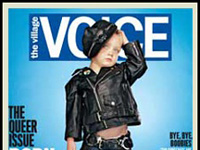
The Village Voice
Wish Hue Were THere
Daniel Kunitz
For decades, people saw color photography in black and white: It was for amateurs or crass commercialism; it was emphatically not for art. Kodacolor, considered the first true color negative film, was introduced in 1942. As late as 1997, the Oxford History of Art volume on the photograph still claimed, "Color photographs remain problematic. They are central to the snapshot, but are still invariably rejected by the professional and art photographer . . ." By then this assertion was already moldy, yet it gives a sense of how reluctant people were to embrace color. In fact, by 1997, color had become utterly central to photography, in large part because of a renewed appreciation for several American photographers who came to prominence in the '70s. Two current shows presenting work from that decade suggest why our reception of color has been so blurry.
Introducing a show of European color photography, which he has curated at Hasted Hunt Gallery, the well-known photographer Martin Parr laments that in "the rather dysfunctional history of colour photography, the seminal exhibition by William Eggleston in 1976 at MOMA . . . is often cited as the start of serious colour photography." He goes on to mention photographer Stephen Shore's contribution "to the establishement and acceptance" of the medium and notes that, before the '70s, "colour work had predominantly been associated with commercial or even snapshot photography."
Perhaps one major—and generally overlooked—cause of the dysfunction in this history is that, while color might have been central to the snapshot, in the '70s the snapshot also became central to art. And Stephen Shore was crucial in effecting this shift. First in his series American Surfaces (1972) and then in the epochal series Uncommon Places (1973–1978), Shore tweaked the snapshot look into an art form, recording seemingly casual moments from long road trips across America; he captured his meals and the diners in which he ate them, hotels, quiet streets, open vistas. Prints from those two series form the core of "Biographical Landscape," a comprehensive and beautiful exhibition of Shore's early work on view at the International Center of Photography. As a warm-up we get a handful of early black-and-white photos, examples of conceptual work from the period, and a Super-8 movie—all of it intriguing because it demonstrates how Shore was, from the start, engaged not just with photography but also with the broader artistic practices of the time. He made conceptual photographs that recall Robert Smithson's work; he put together shows of found photography; he dabbled in neo-Dadaist pranks.
But in American Surfaces he began to explore alternatives to the black-and-white street photography of the '50s and '60s, as well as to the formal, Modernist photography dominant earlier in the century. Using a 35mm camera, Shore made pictures that were biographical, anecdotal, apparently off-the-cuff, unrepentantly vernacular, at times jokey. He discovered grace in a pair of legs, an open toilet, a grocery store in Utah, a car parked on the street in South Carolina, a curator eating an apple. Uncommon Places covered essentially the same subject matter, except that now he employed a large-format view camera, which slowed the process down, allowing for subtler compositions.
Shore's style became enormously influential. You can find the residue of his vernacular aesthetic in photographers from Nan Goldin to Ryan McGinley. Along with Eggleston's, it came to represent the look of American color photography in the '70s. Parr's show at Hasted Hunt aims, in his words, "to demonstrate that an equally lively colour photography culture in Europe was operating both before and during the '70s." It's a fascinating effort, and the work in it demands more attention. But, to my eye, it's not hard to see why this work failed to infect the imaginations of international viewers.
The six photographers included all work in color, yet each seems beholden to older ways of seeing. Peter Mitchell's images of shops and shop owners in his native Leeds are posed and formal, and (unlike Shore's pictures) they almost never contain cars or other temporal markers. Focusing on beachgoers, Carlos Pérez Siquier, a Spaniard, alternates between formal, abstracted body parts—in a manner reminiscent of, say, Bill Brandt—and rigid, central compositions popping with glossy-mag colors. Compared with the loose and lanky Shore, the European work feels a bit stiff, overly concerned with formally abstract composition, static.
Still, there are a number of gorgeous and forward-looking photographs here. The couple having sex on a blue blanket behind a Dutch farmhouse in Ed Van der Elsken's Edam (paar op erf), 1970, has a refreshing openness, and you can't help chuckling at Luigi Ghirri's image of four tourists confronting a wall map of the Alps, the zigzag of their heads echoing the line of mountains before them. I was especially happy to learn about Keld Helmer-Petersen, a Dane who self-published a book called 122 Colour Photographs—including Texaco and other urban signage—back in 1947.
Shore has already been accorded the status of a master, so "Biographical Landscape" affords a chance at a more resonant understanding of his work. Parr, on the other hand, has done a great service adding unfamiliar accents to what has until now been a story told in an almost exclusively American voice.